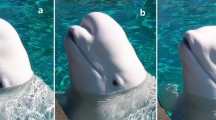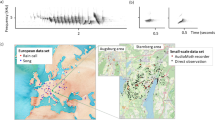Abstract
To determine whether gibbons discriminate among songs given by different groups, I conducted a series of experimental playbacks of recorded Bornean gibbon (Hylobates muelleri)duets. The gibbons did not respond differentially to their own, neighbors’, and strangers’ songs. Failure to show vocal discrimination may be due to factors associated with the experimental procedure or may indicate that there is no selective advantage gained by responding differentially under the playback circumstances.
Similar content being viewed by others
References
Brooks, R., and Falls, J. B. (1975). Individual recognition by song in white-throated sparrows. I. Discrimination of songs of neighbors and strangers.Can. J. Zool. 53: 879–888.
Cheney, D., and Seyfarth, R. (1980). Vocal recognition in free-ranging vervet monkeys.Anim. Behav. 28: 362–367.
Ellefson, J. (1974). A natural history of the white-handed gibbon in the Malayan peninsula. In Rumbaugh, D. (ed.),Gibbon and Siamang, Vol. 3, Karger, Basel, pp. 1–136.
Emlen, S. (1971). The role of song in individual recognition in the indigo bunting.Z. Tierpsychol. 28: 241–246.
Falls, J. B. (1982). Individual recognition by sounds in birds. In Kroodsma, D., and Miller, E. (eds.),Acoustic Communication in Birds, Vol. 2. Song Learning and its Consequences, Academic Press, New York, pp. 237–278.
Gittins, S. P. (1980). Territorial behavior in the agile gibbon.Int. J. Primatol. 1: 381–399.
Hansen, E. (1976). Selective responding by recently separated juvenile rhesus monkeys to the calls of their mothers.Dev. Psychobiol. 9: 83–88.
Kaplan, J., Winship-Ball, A., and Sim, L. (1978). Maternal discrimination of infant vocalizations in squirrel monkeys.Primates 19: 187–193.
Kroodsma, D. (1976). The effect of large song repertoires on neighbor “recognition” in male song sparrows.Condor 78: 97–99.
Krebs, J. (1977). Song and territory in the great tit. In Stonehouse, B., and Perrins, C. (eds.),Evolutionary Ecology, Macmillan, London, pp. 47–62.
Marshall, J., and Marshall, E. (1976). Gibbons and their territorial songs.Science 193: 235–237.
Mitani, J. (1985). Gibbon song duets and intergroup spacing.Behaviour (in press).
Richards, D., and Wiley, R. H. (1980). Reverberations and amplitude fluctuations in the propagation of sound in forest: Implications for animal communication.Am. Nat. 115: 381–399.
Siegel, S. (1956).Nonparametric Statistics for the Behavioral Sciences, McGraw-Hill, New York.
Snowdown, C., and Cleveland, J. (1980). Individual recognition of contact calls by pygmy marmosets.Anim. Behav. 28: 717–727.
Tenaza, R. (1976). Songs, choruses and countersinging of Kloss’ gibbons (Hylobates klossi) in Siberut Island.Z. Tierpsychol. 40: 37–52.
Waser, P. (1977). Individual recognition, intragroup cohesion and intergroup spacing: Evidence from sound playback to forest monkeys.Behaviour 60: 28–74.
Author information
Authors and Affiliations
Rights and permissions
About this article
Cite this article
Milani, J.C. Responses of gibbons (Hylobates muelleri) to self, neighbor, and stranger song duets. Int J Primatol 6, 193–200 (1985). https://doi.org/10.1007/BF02693653
Received:
Revised:
Issue Date:
DOI: https://doi.org/10.1007/BF02693653




